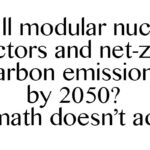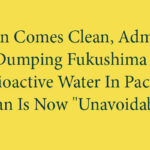by Susan O’Donnell, Gordon Edwards, M.V. RamanaApril 4, 2021
The Government of New Brunswick has committed $30 million to develop two small modular nuclear reactor (SMR) projects on the Bay of Fundy next to the Point Lepreau reactor. The federal government contributed $56 million more in public funds to this scheme. These investments are unlikely to succeed and will delay climate action.
Both SMR designs are based on technologies with a known record of problems and commercial failures. More generally, SMRs are a bad strategy for tackling climate change: high cost and not ready. We have elaborated on the problems with SMRs in a longer briefing paper for Minister Mike Holland, which is available on the University of New Brunswick RAVEN project website.
The first design, the ARC-100, is based on the EBR-2, an experimental U.S. reactor never operated outside a laboratory. It uses molten sodium to cool the fuel. Such reactors have had numerous sodium leaks, causing fires and clean up problems. Some have suffered severe accidents, including partial nuclear meltdowns at the EBR-1 experiment and Fermi-1 power plant in the United States. Sodium cooled reactors have been more expensive to construct on a capacity basis than heavy water reactors like Point Lepreau.
The Moltex design is based, in part, on two reactors built decades ago at the U.S. Oak Ridge National Laboratory that operated for 100 hours and less than four years, respectively. The latter reactor’s operations were interrupted 225 times due to various problems. It is no surprise that no further molten salt reactors have been constructed.
Similar problems plague many “advanced” nuclear reactor designs. A recent report from the Union of Concerned Scientists in the U.S. laid out a range of safety and security risks associated with such designs. As explained in greater detail in an academic paper, such reactor designs are simply not ready for deployment or commercialization because of technical problems.
Both reactor designs for New Brunswick also envision chemical processing of irradiated (used) reactor fuel bundles. This theoretical “recycling” process will create new radioactive liquid waste streams, requiring long-term storage. It will also produce plutonium in forms usable in nuclear explosives, necessitating heightened security at Point Lepreau.
The U.S. Nuclear Regulatory Commission recently discontinued laying down rules for “recycling” used nuclear fuel because of lack of commercial interest. If U.S. companies are not interested in commercializing this technology, why does the government believe New Brunswick will have more success?
The New Brunswick’s government’s arguments for investing in these reactor designs are not based on fact. For example, the 2020 speech from the throne cited the potential economic benefits of capturing just one percent of an “estimated Canadian market” for SMRs. This putative market largely consists of remote off-grid sites currently using diesel to generate electricity.
However, our research found the electricity from SMRs would cost up to ten times more than diesel-based electricity. At these costs, it is unlikely that many of these remote sites would buy SMRs. Further, even under the optimistic assumption that all of them do, the total electricity demand is insufficient to justify the cost of setting up factories to manufacture SMRs.
Under federal law, NB Power’s Belledune coal-fired plant must be phased out by 2030. The ARC-100 and Moltex designs are not yet licensed to operate in Canada. Because the Canadian Nuclear Safety Commission has never licensed reactors based on the proposed designs, even understanding the safety challenges and analyzing accident modes will take years, if not decades. Waiting to build SMRs amounts to delaying climate action.
The most reliable, available and affordable climate change mitigation path for New Brunswick involves rapidly expanding renewable energy infrastructure, refurbishing the Mactaquac facility, investing aggressively in energy efficiency, and upgrading interconnections to increase hydropower imports from the Atlantic Loop and Quebec.
Investing in SMRs is incompatible with this path. A recent academic paper analyzing carbon emissions and investments in energy technologies in 123 countries showed that nuclear power investments crowd out renewables and lead to lower emission reductions. One cannot have both: nuclear power and sustainable renewable energy.
Spending public money on unproven nuclear reactor concepts is a path to escalating power rates, long-term liabilities, delaying more immediate climate action, and complicating the growing radioactive waste legacy that will burden future generations.
This article also appeared in the Brunswick News papers in Saint John, Fredericton and Moncton.
Susan O’Donnell is a Researcher and Adjunct Professor at the University of New Brunswick in Fredericton. She represents the UNB RAVEN research project in the Coalition for Responsible Energy Development in New Brunswick (CRED-NB).
Gordon Edwards is a scientist, nuclear consultant, and President of the Canadian Coalition for Nuclear Responsibility.
M.V. Ramana is the Simons Chair in Disarmament, Global and Human Security and Director of the Liu Institute for Global Issues at the School of Public Policy and Global Affairs, University of British Columbia, Vancouver, and a Scholar at the Peter Wall Institute for Advanced Studies.
Source: https://nbmediacoop.org/2021/04/04/more-nuclear-reactors-smrs-a-bad-investment-for-new-brunswick/


